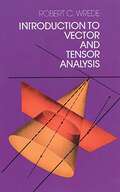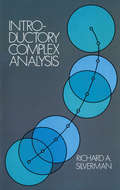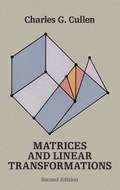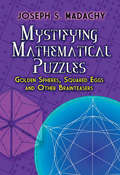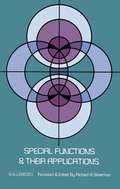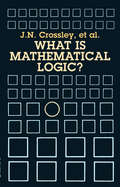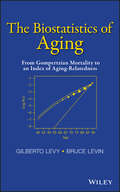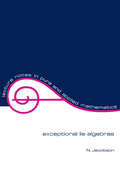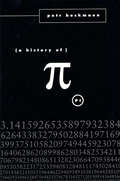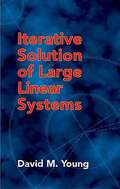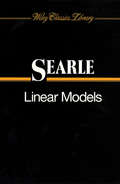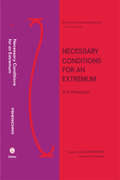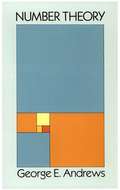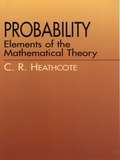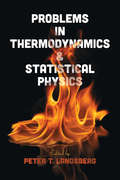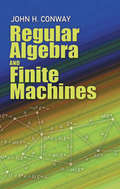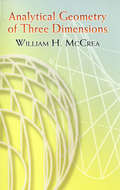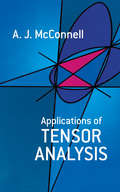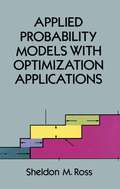- Table View
- List View
Introduction to Vector and Tensor Analysis
by Robert C. WredeA broad introductory treatment, this volume examines general Cartesian coordinates, the cross product, Einstein's special theory of relativity, bases in general coordinate systems, maxima and minima of functions of two variables, line integrals, integral theorems, fundamental notions in n-space, Riemannian geometry, algebraic properties of the curvature tensor, and more. 1963 edition.
Introductory Complex Analysis (Dover Books on Mathematics)
by Richard A. SilvermanIntroductory Complex Analysis is a scaled-down version of A. I. Markushevich's masterly three-volume "Theory of Functions of a Complex Variable." Dr. Richard Silverman, the editor and translator of the original, has prepared this shorter version expressly to meet the needs of a one-year graduate or undergraduate course in complex analysis. In his selection and adaptation of the more elementary topics from the original larger work, he was guided by a brief course prepared by Markushevich himself.The book begins with fundamentals, with a definition of complex numbers, their geometric representation, their algebra, powers and roots of complex numbers, set theory as applied to complex analysis, and complex functions and sequences. The notions of proper and improper complex numbers and of infinity are fully and clearly explained, as is stereographic projection. Individual chapters then cover limits and continuity, differentiation of analytic functions, polynomials and rational functions, Mobius transformations with their circle-preserving property, exponentials and logarithms, complex integrals and the Cauchy theorem , complex series and uniform convergence, power series, Laurent series and singular points, the residue theorem and its implications, harmonic functions (a subject too often slighted in first courses in complex analysis), partial fraction expansions, conformal mapping, and analytic continuation.Elementary functions are given a more detailed treatment than is usual for a book at this level. Also, there is an extended discussion of the Schwarz-Christolfel transformation, which is particularly important for applications.There is a great abundance of worked-out examples, and over three hundred problems (some with hints and answers), making this an excellent textbook for classroom use as well as for independent study. A noteworthy feature is the fact that the parentage of this volume makes it possible for the student to pursue various advanced topics in more detail in the three-volume original, without the problem of having to adjust to a new terminology and notation .In this way, IntroductoryComplex Analysis serves as an introduction not only to the whole field of complex analysis, but also to the magnum opus of an important contemporary Russian mathematician.
The Limits to Growth: A Report for the Club of Rome's Project on the Predicament of Mankind
by Donella H. Meadows Dennis L. Meadows Jorgen Randers William W. Behrens IIIA report from The Club of Rome, an informal organization that has been aptly described as an "invisible college." Its purposes are to foster understanding of the varied but interdependent components-- economic, political, natural, and social-- that make up the global system in which we all live; to bring that new understanding to the attention of policy-makers and the public worldwide; and in this way to promote new policy initiatives and action. This report caused much controversy when it was published.
Matrices and Linear Transformations: Second Edition
by Charles G. Cullen"Comprehensive . . . an excellent introduction to the subject." -- Electronic Engineer's Design Magazine.This introductory textbook, aimed at sophomore- and junior-level undergraduates in mathematics, engineering, and the physical sciences, offers a smooth, in-depth treatment of linear algebra and matrix theory. The major objects of study are matrices over an arbitrary field. Contents include Matrices and Linear Systems; Vector Spaces; Determinants; Linear Transformations; Similarity: Part I and Part II; Polynomials and Polynomial Matrices; Matrix Analysis; and Numerical Methods. The first seven chapters, which require only a first course in calculus and analytic geometry, deal with matrices and linear systems, vector spaces, determinants, linear transformations, similarity, polynomials, and polynomial matrices. Chapters 8 and 9, parts of which require the student to have completed the normal course sequence in calculus and differential equations, provide introductions to matrix analysis and numerical linear algebra, respectively. Among the key features are coverage of spectral decomposition, the Jordan canonical form, the solution of the matrix equation AX = XB, and over 375 problems, many with answers.
Mystifying Mathematical Puzzles: Golden Spheres, Squared Eggs and Other Brainteasers
by Joseph S. Madachy"Fans will find this volume indispensable; casual readers will find it an attractive nuisance," observed The Scientific American of this rich and challenging compilation of puzzles. From brainteasers that any novice can figure out to complex problems involving number theory, this puzzle treasury offers a splendid variety of conundrums. Readers can follow the path of the bouncing billiard balls, search for the lost chord, size up golden spheres, calculate the number of squared eggs, and take on dozens of other imaginative challenges, including diabolic squares, flexagons, domino games, and geometric dissections. Assembled by Joseph S. Madachy, lead editor of the Journal of Recreational Mathematics, this collection features problems as well as classical puzzles, many of which offer fascinating insights into the nature of mathematics. Mystifying Mathematical Puzzles provides excellent entertainment for puzzle enthusiasts of every level and is ideal for home or classroom use. Complete solutions to all puzzles are included.
Special Functions & Their Applications (Dover Books on Mathematics)
by N. N. Lebedev Richard R. SilvermanRichard Silverman's new translation makes available to English readers the work of the famous contemporary Russian mathematician N. N. Lebedev. Though extensive treatises on special functions are available, these do not serve the student or the applied mathematician as well as Lebedev's introductory and practically oriented approach. His systematic treatment of the basic theory of the more important special functions and the applications of this theory to specific problems of physics and engineering results in a practical course in the use of special functions for the student and for those concerned with actual mathematical applications or uses. In consideration of the practical nature of the coverage, most space has been devoted to the application of cylinder functions and particularly of spherical harmonics. Lebedev, however, also treats in some detail: the gamma function, the probability integral and related functions, the exponential integral and related functions, orthogonal polynomials with consideration of Legendre, Hermite and Laguerre polynomials (with exceptional treatment of the technique of expanding functions in series of Hermite and Laguerre polynomials), the Airy functions, the hypergeometric functions (making this often slighted area accessible to the theoretical physicist), and parabolic cylinder functions. The arrangement of the material in the separate chapters, to a certain degree, makes the different parts of the book independent of each other. Although a familiarity with complex variable theory is needed, a serious attempt has been made to keep to a minimum the required background in this area. Various useful properties of the special functions which do not appear in the text proper will be found in the problems at the end of the appropriate chapters. This edition closely adheres to the revised Russian edition (Moscow, 1965). Richard Silverman, however, has made the book even more useful to the English reader. The bibliography and references have been slanted toward books available in English or the West European languages, and a number of additional problems have been added to this edition.
What Is Mathematical Logic? (Dover Books on Mathematics)
by J. N. Crossley J. C. Stillwell C. J. Brickhill C. J. AshAlthough mathematical logic can be a formidably abstruse topic, even for mathematicians, this concise book presents the subject in a lively and approachable fashion. It deals with the very important ideas in modern mathematical logic without the detailed mathematical work required of those with a professional interest in logic.The book begins with a historical survey of the development of mathematical logic from two parallel streams: formal deduction, which originated with Aristotle, Euclid, and others; and mathematical analysis, which dates back to Archimedes in the same era. The streams began to converge in the seventeenth century with the invention of the calculus, which ultimately brought mathematics and logic together. The authors then briefly indicate how such relatively modern concepts as set theory, Gödel's incompleteness theorems, the continuum hypothesis, the Löwenheim-Skolem theorem, and other ideas influenced mathematical logic. The ideas are set forth simply and clearly in a pleasant style, and despite the book's relative brevity, there is much covered on these pages. Nonmathematicians can read the book as a general survey; students of the subject will find it a stimulating introduction. Readers will also find suggestions for further reading in this lively and exciting area of modern mathematics.
The Biostatistics of Aging
by Bruce Levin Gilberto LevyA practical and clarifying approach to aging and aging-related diseasesProviding a thorough and extensive theoretical framework, The Biostatistics of Aging: From Gompertzian Mortality to an Index of Aging-Relatedness addresses the surprisingly subtlenotion--with consequential biomedical and public health relevance--of what it means for acondition to be related to aging. In this pursuit, the book presents a new quantitative methodto examine the relative contributions of genetic and environmental factors to mortality anddisease incidence in a population.With input from evolutionary biology, population genetics, demography, and epidemiology, this medically motivated book describes an index of aging-relatedness and also features:Original results on the asymptotic behavior of the minimum of time-to-event random variables, which extends those of the classical statistical theory of extreme valuesA comprehensive and satisfactory explanation based on biological principles of the Gompertz pattern of mortality in human populationsThe development of an evolution-based model of causation relevant to mortality and aging-related diseases of complex etiologyAn explanation of how and why the description of human mortality by the Gompertz distribution can be improved upon from first principlesThe amply illustrated analysis of real-world data, including a program for conducting the analysis written in the freely available R statistical softwareTechnical appendices including mathematical material as well as an extensive and multidisciplinary bibliography on aging and aging-related diseasesThe Biostatistics of Aging: From Gompertzian Mortality to an Index of Aging-Relatedness is an excellent resource for practitioners and researchers with an interest in aging and aging-related diseases from the fields of medicine, biology, gerontology, biostatistics, epidemiology, demography, and public health.
Exceptional Lie Algebras (Lecture Notes in Pure and Applied Mathematics #1)
by N. JacobsonThis volume presents a set of models for the exceptional Lie algebras over algebraically closed fieldsof characteristic O and over the field of real numbers. The models given are based on the algebras ofCayley numbers (octonions) and on exceptional Jordan algebras. They are also valid forcharacteristics p * 2. The book also provides an introduction to the problem of forms of exceptionalsimple Lie algebras, especially the exceptional D4 's, � 6 's, and � 7 's. These are studied by means ofconcrete realizations of the automorphism groups.Exceptional Lie Algebras is a useful tool for the mathematical public in general-especially thoseinterested in the classification of Lie algebras or groups-and for theoretical physicists.
A History of Pi
by Petr BeckmannThe history of pi, says the author, though a small part of the history of mathematics, is nevertheless a mirror of the history of man. Petr Beckmann holds up this mirror, giving the background of the times when pi made progress -- and also when it did not, because science was being stifled by militarism or religious fanaticism.
Introduction to Probability Theory
by Paul G. Hoel Sidney C. Port Charles J. StoneRandom Walks and Poisson Processes Combinatorial Analysis Discrete Random Variables Expectation of Discrete Random Variables Continuous Random Variables Jointly Distributed Random Variables Expectations and the Central Limit Theorem Moment Generating Functions and Characteristic Functions Probability Spaces
Iterative Solution of Large Linear Systems
by David M. YoungThis self-contained treatment offers a systematic development of the theory of iterative methods. Its focal point resides in an analysis of the convergence properties of the successive overrelaxation (SOR) method, as applied to a linear system with a consistently ordered matrix. The text explores the convergence properties of the SOR method and related techniques in terms of the spectral radii of the associated matrices as well as in terms of certain matrix norms. Contents include a review of matrix theory and general properties of iterative methods; SOR method and stationary modified SOR method for consistently ordered matrices; nonstationary methods; generalizations of SOR theory and variants of method; second-degree methods, alternating direction-implicit methods, and a comparison of methods. 1971 edition.
Linear Models
by Shayle R. SearleThis 1971 classic on linear models is once again available--as a Wiley Classics Library Edition. It features material that can be understood by any statistician who understands matrix algebra and basic statistical methods.
Moja Means One: A Swahili Counting Book
by Muriel L. FeelingsA counting book that portrays the life and culture of Swahili-speaking Africa, with a brief text and dramatic illustrations. The numbers one through ten in Swahili accompany two-page illustrations of various aspects of East African life.
Necessary Conditions for an Extremum
by B.N. PshenichnyiThis book presents a theory of necessary conditions for an extremum, including formal conditions for an extremum and computational methods. It states the general results of the theory and shows how these results can be particularized to specific problems.
Number Theory: The Theory Of Partitions (Dover Books on Mathematics #Vol. 2)
by George E. AndrewsAlthough mathematics majors are usually conversant with number theory by the time they have completed a course in abstract algebra, other undergraduates, especially those in education and the liberal arts, often need a more basic introduction to the topic.In this book the author solves the problem of maintaining the interest of students at both levels by offering a combinatorial approach to elementary number theory. In studying number theory from such a perspective, mathematics majors are spared repetition and provided with new insights, while other students benefit from the consequent simplicity of the proofs for many theorems.Among the topics covered in this accessible, carefully designed introduction are multiplicativity-divisibility, including the fundamental theorem of arithmetic, combinatorial and computational number theory, congruences, arithmetic functions, primitive roots and prime numbers. Later chapters offer lucid treatments of quadratic congruences, additivity (including partition theory) and geometric number theory.Of particular importance in this text is the author's emphasis on the value of numerical examples in number theory and the role of computers in obtaining such examples. Exercises provide opportunities for constructing numerical tables with or without a computer. Students can then derive conjectures from such numerical tables, after which relevant theorems will seem natural and well-motivated..
Probability: Elements of the Mathematical Theory
by C. R. HeathcoteDesigned for students studying mathematical statistics and probability after completing a course in calculus and real variables, this text deals with basic notions of probability spaces, random variables, distribution functions and generating functions, as well as joint distributions and the convergence properties of sequences of random variables. Includes worked examples and over 250 exercises with solutions.
Problems in Thermodynamics and Statistical Physics (Dover Books on Physics)
by Peter T. LandsbergWell respected and widely used, this volume presents problems and full solutions related to a wide range of topics in thermodynamics, statistical physics, and statistical mechanics. The text is intended for instructors, undergraduates, and graduate students of mathematics, physics, chemistry, and engineering. Twenty-eight chapters, each prepared by an expert, proceed from simpler to more difficult subjects. Similarly, the early chapters are easier than the later ones, making the book ideal for independent study.Subjects begin with the laws of thermodynamics and statistical theory of information and of ensembles, advancing to the ideal classical gases of polyatomic molecules, non-electrolyte liquids and solutions, and surfaces. Subsequent chapters explore imperfect classical and quantum gas, phase transitions, cooperative phenomena, Green function methods, the plasma, transport in gases and metals, Nyquist's theorem and its generalizations, stochastic methods, and many other topics.
Regular Algebra and Finite Machines
by John Horton ConwayWorld-famous mathematician John H. Conway based this classic text on a 1966 course he taught at Cambridge University. Geared toward graduate students of mathematics, it will also prove a valuable guide to researchers and professional mathematicians.His topics cover Moore's theory of experiments, Kleene's theory of regular events and expressions, Kleene algebras, the differential calculus of events, factors and the factor matrix, and the theory of operators. Additional subjects include event classes and operator classes, some regulator algebras, context-free languages, communicative regular algebra, axiomatic questions, the strength of classical axioms, and logical problems. Complete solutions to problems appear at the end.
الأخلاق والسير في مداواة النفوس
by أبي محمد علي بن حزم الأندلسي الظاهريقد جمعت في كتابي هذا معان كثيرة أفادنيها واهب التمييز تعالى بمرور الأيام وتعاقب الأحوال بما منحني عز وجل من التهمم بتصاريف الزمان والإشراف على أحواله حتى أنفقت في ذلك أكثر عمري وآثرت تقييد ذلك بالمطالعة له والفكرة فيه على جميع اللذات التي تميل إليها أكثر النفوس وعلى الازدياد من فضول المال ورقمت كل ما سبرت من ذلك بهذا الكتاب لينفع الله تعالى به من شاء من عباده ممن يصل إليه ما أتعبت فيه نفسي واجهدتها فيه واطلت فيه فكري فيأخذه عفوا وأهديته إليه هنيئا فيكون ذلك أفضل له من كنوز المال وعقد الأملاك إذا تدبره ويسره الله تعلي لاستعماله. وانا راج في ذلك من الله تعالي أعظم الأجر لنيتي في نفع عباده وإصلاح ما فسد من أخلاقهم ومداواة علل نفوسهم وبالله تعالى استعين وحسبنا الله ونعم الوكيل
ABC's of Science
by Charles A. OliverThis books is about alpha, beta, and gamma. These are the first three letters of the Greek alphabet. <P> <P> This alphabet was the major method of written communication in ancient times, and is of course still used today. The Greek letters are also the most commonly used symbols in science. In all branches of science, we use symbols to represent ideas and definitions. Symbols serve to simplify communication and calculations—once you get used to them, that is.
Analytical Geometry of Three Dimensions: Second Revised Version
by William H. McCreaBrief but rigorous, this text is geared toward advanced undergraduates and graduate students. It covers the coordinate system, planes and lines, spheres, homogeneous coordinates, general equations of the second degree, quadric in Cartesian coordinates, and intersection of quadrics.Mathematician, physicist, and astronomer, William H. McCrea conducted research in many areas and is best known for his work on relativity and cosmology. McCrea studied and taught at universities around the world, and this book is based on a series of his lectures.
Applications of Tensor Analysis (Dover Books on Mathematics)
by A. J. McConnellThis standard work applies tensorial methods to subjects within the realm of advanced college mathematics. In its four main divisions, it explains the fundamental ideas and the notation of tensor theory; covers the geometrical treatment of tensor algebra; introduces the theory of the differentiation of tensors; and applies mathematics to dynamics, electricity, elasticity, and hydrodynamics.Partial contents: algebraic preliminaries (notation, definitions, determinants, tensor analysis); algebraic geometry (rectilinear coordinates, the plane, the straight line, the quadric cone and the conic, systems of cones and conics, central quadrics, the general quadric, affine transformations); differential geometry (curvilinear coordinates, covariant differentiation, curves in a space, intrinsic geometry of a surface, fundamental formulae of a surface, curves on a surface); applied mathematics (dynamics of a particles, dynamics of rigid bodies, electricity and magnetism, mechanics of continuous media, special theory of relativity).
Applied Probability Models with Optimization Applications
by Sheldon M. Ross"A clarity of style and a conciseness of treatment which students will find most welcome. The material is valuable and well organized ... an excellent introduction to applied probability." -- Journal of the American Statistical Association. This book offers a concise introduction to some of the stochastic processes that frequently arise in applied probability. Emphasis is on optimization models and methods, particularly in the area of decision processes. After reviewing some basic notions of probability theory and stochastic processes, the author presents a useful treatment of the Poisson process, including compound and nonhomogeneous Poisson processes. Subsequent chapters deal with such topics as renewal theory and Markov chains; semi-Markov, Markov renewal, and regenerative processes; inventory theory; and Brownian motion and continuous time optimization models.Each chapter is followed by a section of useful problems that illustrate and complement the text. There is also a short list of relevant references at the end of every chapter. Students will find this a largely self-contained text that requires little previous knowledge of the subject. It is especially suited for a one-year course in applied probability at the advanced undergraduate or beginning postgraduate level. 1970 edition.
